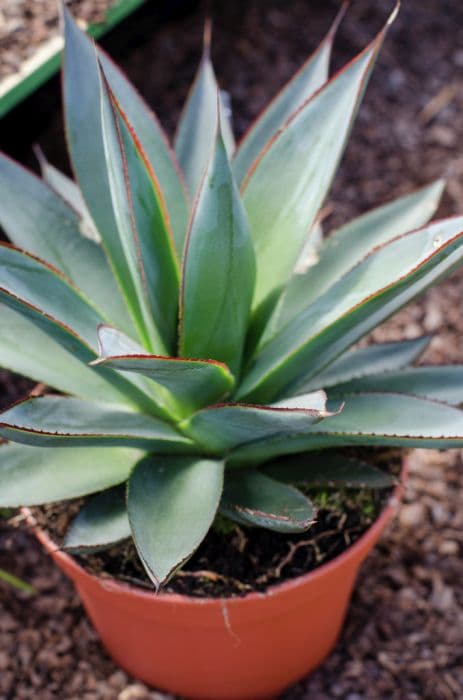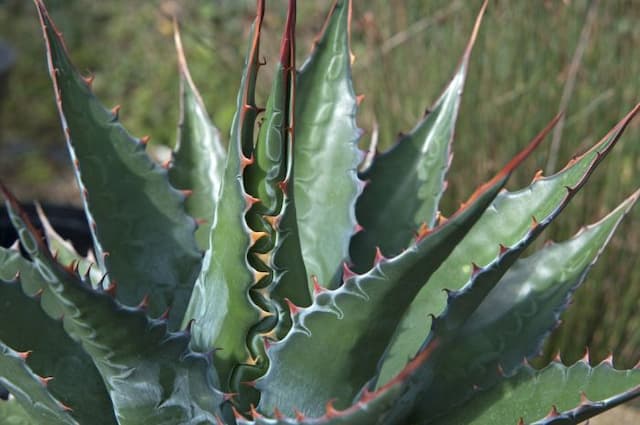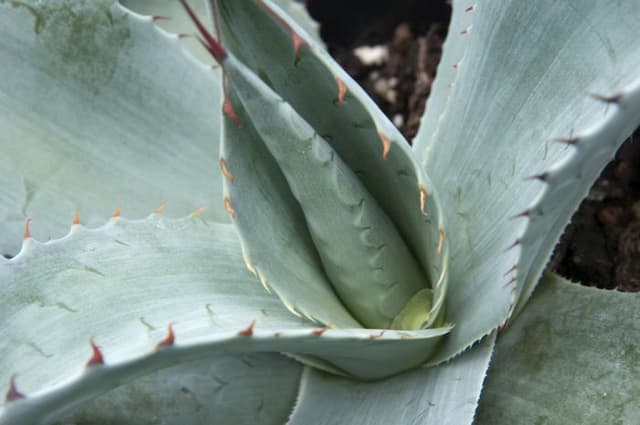Hosta Hosta 'Smiling Mouse' (v)

ABOUT
Hosta 'Smiling Mouse' is a charming perennial plant known for its ornamental foliage. The leaves of this variety have a distinctive heart shape with a slight waviness to the edges, creating a plush and textured look. The foliage appears thick and has a notable blue-green color, providing a lush backdrop in gardens. Adding to its appeal, the leaves sometimes showcase variegation, with creamy white to pale yellow margins that contrast attractively against the blue-green centers, giving the leaves a striking appearance. In summer, the plant produces delicate flowers on slender stalks that rise above the foliage. These flowers are typically bell-shaped and can be a light lavender or purple shade, adding a touch of delicate beauty to the robust leaf display below. Overall, Hosta 'Smiling Mouse' presents a picturesque clump of foliage and blooms that add a cool, serene hue and a touch of whimsy to garden spaces.
About this plant
 Names
NamesFamily
Asparagaceae
Synonyms
Plantain Lily, Funkia, Hosta
Common names
Hosta 'Smiling Mouse'
 Toxicity
ToxicityTo humans
Hostas, including the variety 'Smiling Mouse', are generally considered safe for humans and are not known to be toxic. However, they are not intended for consumption, and if ingested in large quantities, they may cause mild stomach upset due to the plant's fibrous nature.
To pets
Hostas can be toxic to pets, particularly to dogs and cats. If a pet ingests any part of a hosta plant, it may experience symptoms such as vomiting, diarrhea, and depression. It's important for pet owners to be aware that the saponins present in the plant can cause these adverse reactions and to keep hostas out of reach of their pets to avoid possible poisoning.
 Characteristics
CharacteristicsLife cycle
Perennials
Foliage type
Deciduous
Color of leaves
Variegated
Flower color
Lavender
Height
1 foot [30 cm]
Spread
2 feet [60 cm]
Plant type
Herb
Hardiness zones
3
Native area
Asia
Benefits
 General Benefits
General Benefits- Ornamental Appeal: Hosta 'Smiling Mouse' adds visual interest to gardens with its uniquely shaped leaves and attractive variegation.
- Shade Tolerance: It thrives in shady areas where many other plants may struggle to grow, making it ideal for wooded gardens or north-facing sites.
- Low Maintenance: Hostas are known for being relatively easy to care for, requiring minimal attention once established.
- Drought Resistance: Once established, they can withstand periods of dryness, requiring less frequent watering compared to many other garden plants.
- Pest Resistance: 'Smiling Mouse' is resistant to many pests, reducing the need for chemical interventions.
- Versatility: Hostas can be used in a variety of garden designs, including borders, ground covers, and as accent plants.
- Long-Lived Perennial: It will return year after year, providing long-term value and reducing the need for annual replanting.
- Seasonal Interest: Hostas provide interest from spring to fall with their foliage and sometimes with their flowers.
- Soil Adaptability: Hostas can adapt to a range of soil conditions, although they prefer well-drained, nutrient-rich soils.
- Cold Hardy: They are capable of surviving in colder climates, making them suitable for many temperate gardens.
 Medical Properties
Medical PropertiesThis plant is not used for medical purposes.
 Air-purifying Qualities
Air-purifying QualitiesThis plant is not specifically known for air purifying qualities.
 Other Uses
Other Uses- Hostas can be used in floral arrangements to add lush greenery and textural contrast. 'Smiling Mouse' with its unique foliage can add a quirky touch to bouquets.
- These plants can serve as a natural dye source. The leaves of 'Smiling Mouse' could potentially yield green hues for fabric coloring.
- Hostas are sometimes used in pet enclosures for reptiles or amphibians as non-toxic landscaping that mimics their natural habitat.
- They can be a learning tool in schools for teaching children about plant growth, biology, and horticulture due to their ease of growth and care.
- 'Smiling Mouse' can be utilized in art projects, such as leaf printing or nature-inspired crafts, providing an interesting leaf shape for impressions.
- Hostas can be used as living mulch, helping to keep the soil moist and reducing weed growth around other plants.
- In large pots, Hostas like 'Smiling Mouse' could be used to create movable garden accents that can be relocated as needed for design or light requirements.
- Certain varieties of Hostas are used in ponds or water gardens as marginal plants, although 'Smiling Mouse's tolerance to such conditions should be checked.
- Hosta plants, due to their dense foliage, can be used to prevent soil erosion on slight slopes in the garden setting.
- Leaf casts can be made from the foliage of 'Smiling Mouse', creating permanent decorative items that capture the intricate vein patterns of the leaves.
Interesting Facts
 Feng Shui
Feng ShuiThe plant Hosta is not used in Feng Shui practice.
 Zodiac Sign Compitability
Zodiac Sign CompitabilityThe plant Hosta is not used in astrology practice.
 Plant Symbolism
Plant Symbolism- Resilience: Hostas, including 'Smiling Mouse', are known for their hardy nature and ability to thrive in shady areas where other plants may struggle, symbolizing the ability to endure and prosper under difficult conditions.
- Devotion: With their lush foliage that returns faithfully each year, hostas can represent devotion or loyalty in the plant symbolism world, reflecting the steadfast aspects of relationships or personal commitment.
- Self-care: The 'Smiling Mouse' variety, with its compact size and charming appearance, may suggest the importance of self-care and finding joy in the small, personal nooks of life.
- Adaptability: Hostas are adaptable plants that can adjust to various soil types and shade levels. This trait symbolizes flexibility and the ability to thrive in diverse environments or situations.
 Water
WaterHostas, including 'Smiling Mouse', prefer consistently moist soil, so water them deeply once a week with about an inch of water, which is approximately 0.6 gallons for a small to medium-sized plant. During hot or dry spells, you may need to water twice a week. Be sure to water the soil directly rather than overhead to prevent water from collecting on the leaves, which can lead to fungal diseases. Adjust your watering schedule based on rainfall and temperatures, reducing the frequency as the weather cools or increases in excessive heat.
 Light
LightHostas, including 'Smiling Mouse', thrive best in partial to full shade conditions. They should be planted in a location where they receive morning light but are protected from the harsh afternoon sun. Too much direct sunlight can cause their leaves to scorch.
 Temperature
TemperatureHostas such as 'Smiling Mouse' grow best in temperatures ranging from 50°F to 75°F. They can survive temperatures down to about 30°F but should be protected from harsh frosts. The ideal growing condition would provide a moderate climate without extreme heat, as temperatures consistently above 85°F can stress the plants.
 Pruning
PruningHostas including 'Smiling Mouse', require little pruning. Remove spent flower stalks after they have finished blooming to keep the plant looking tidy and redirect energy to the foliage. Trim away any damaged or yellowing leaves throughout the growing season. The best time for any significant cleanup is early spring or late fall when you can remove any dead foliage to prevent diseases and pests.
 Cleaning
CleaningAs needed
 Soil
SoilHostas prefer well-draining soil rich in organic matter with a pH between 6.0 and 7.5. A mix of one part garden soil, one part peat moss or compost, and one part perlite or coarse sand is ideal for the 'Smiling Mouse' hosta.
 Repotting
RepottingHostas like 'Smiling Mouse' generally need repotting every 3-5 years or when the root system outgrows the container. The best time to repot is in the early spring before the leaves fully emerge.
 Humidity & Misting
Humidity & MistingHostas thrive in moderate humidity levels but are quite adaptable and can tolerate a range of conditions. For 'Smiling Mouse', aim for a humidity level between 40-70%.
 Suitable locations
Suitable locationsIndoor
Place hosta 'Smiling Mouse' in bright, indirect light with well-draining soil.
Outdoor
Plant hosta 'Smiling Mouse' in shade to part-shade and moist soil.
Hardiness zone
3-9 USDA
 Life cycle
Life cycleThe Hosta 'Smiling Mouse' life cycle starts with seed germination, which occurs in moist, well-draining soil with some shade. Following germination, seedlings emerge and develop into juvenile plants, establishing a root system and foliage through photosynthesis. As the plant matures, it enters a vegetative stage in which it produces large, heart-shaped leaves that are variegated with a hallmark ripple effect along the margins. Over time, the Hosta 'Smiling Mouse' may produce lavender flowers atop tall stalks during the summer months, which is its reproductive phase and can attract pollinators like bees. After flowering and potential seed production, the plant enters a period of dormancy during the colder months, with leaves dying back to ground level. Come spring, the Hosta 'Smiling Mouse' re-emerges from the rootstock to continue its life cycle anew.
 Propogation
PropogationPropogation time
Spring-Early Summer
For the Hosta 'Smiling Mouse', the most popular method of propagation is division. This is typically done in late summer to early fall, or in spring as the Hosta is emerging from dormancy. To propagate by division, gently lift the entire Hosta clump from the ground and clear away any excess soil. Using a sharp knife or spade, carefully split the clump into smaller sections, ensuring that each section has at least two or three shoots and an adequate amount of roots. Replant these divisions immediately in prepared soil, maintaining the same planting depth as the original plant. Water the newly planted divisions thoroughly to help establish them. This method allows gardeners to create new plants that are genetically identical to the parent, ensuring the unique characteristics of the 'Smiling Mouse' Hosta are preserved.









